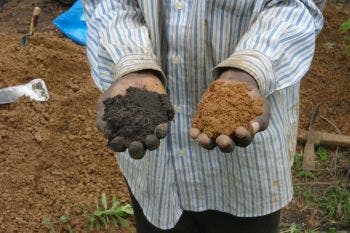A farming technique practiced by West African villagers for centuries could drastically improve farming throughout the entire continent, as well as mitigate climate change.

Comparison between fertile and unfertile soil. Photo credit: Victoria Frauisn, University of Sussex.
Soil quality is a growing issue in many parts of the world. There are only so many nutrients in the soil, erosion is becoming a bigger problem, and water availability is also tightening up – so finding ways to improve soil quality can go a long way. A global study, led by the University of Sussex in collaboration with soil scientists from Cornell, Accra, and Aarhus Universities and the Institute of Development Studies found an interesting solution for many communities in Africa.
The team analyzed 150 sites in northwest Liberia and 27 sites in Ghana, finding that these highly fertile soils contain 2-3 times more organic carbon than other soils, and they are capable of support far more intensive farming. The solution isn’t new – on the contrary. It has been used in one way or another for hundreds of years. These soils were also poor in nutrients once, but they were treated with charcoal (bio-char) and kitchen waste, and it did wonders. Professor James Fairhead, from the University of Sussex, who initiated the study, said:
“Mimicking this ancient method has the potential to transform the lives of thousands of people living in some of the most poverty and hunger stricken regions in Africa. More work needs to be done but this simple, effective farming practice could be an answer to major global challenges such as developing ‘climate smart’ agricultural systems which can feed growing populations and adapt to climate change.”
This is quite different from simply composting, as turning organic matter into char prevents its complete decomposition. When you use compost, it is good for the soil, but it decomposes completely in a few years (up to 10), releasing all the carbon dioxide and methane. Meanwhile, bio-char won’t fully decompose and will keep the CO2 and methane trapped underground, making soils fertile for a much longer time. The creation of bio-char is something that should come pretty easily for most rural African communities. Disposing of ash, bones and other kinds of organic waste is something they need to do on a day to day basis.
What’s interesting is that a similar practice was employed in South America, though the technique might have been different. Dr Dawit Solomon, the lead author from Cornell University, said:
“What is most surprising is that in both Africa and in Amazonia, these two isolated indigenous communities living far apart in distance and time were able to achieve something that the modern-day agricultural management practices could not achieve until now. The discovery of this indigenous climate smart soil-management practice is extremely timely. This valuable strategy to improve soil fertility while also contributing to climate change mitigation and adaptation in Africa could become an important component of the global climate smart agricultural management strategy to achieve food security.”
Now, it’s just a matter of applying the same technique at a greater scale. If we can do that, this small thing could to a massive difference for the African soils – and the African farmers.
The study entitled “Indigenous African soil enrichment as a climate-smart sustainable agriculture alternative”, has been published in the journal Frontiers in Ecology and Environment and can be found here.









